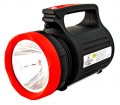Max. operating time
Maximum runtime of the flashlight without changing batteries or recharging the battery.
Note that in models with brightness control, this time is indicated for the most modest and, accordingly, economical mode. For example, in a flashlight with a maximum luminous flux of 1000 lm, the claimed operating time of 20 hours can be achieved at a brightness of only 30 lm, and at maximum battery life may not exceed half an hour. These nuances should be clarified according to the detailed characteristics. However, also note that additional modes of operation (see below) are not taken into account in this case: for example, if the flashlight from our example in SOS mode can operate for 30 hours, the characteristics will still state 20 hours.
It is also worth bearing in mind that for models with replaceable batteries, the actual operating time will also depend on the quality of such batteries. For example, for flashlights for AA and AAA elements, battery life is most often given when using high-quality alkaline batteries; if instead of them inexpensive saline ones are used, the operating time may be several times shorter.
In general, when choosing a flashlight according to the maximum operating time, it does not always make sense to focus on “long-playing” models: they often have either low power or impressive weight / dimensions, and the price can significantly “bite”. Flashlights with a long battery life will be useful first of all to those who have to s...tay “away from civilization” for a long time: extreme tourists, rescuers, military, etc. And for most everyday tasks in a modern city, and even for trips to nature for several days, up to 10 hours is enough.
Battery capacity
The capacity of the battery provided in the design or delivery of the flashlight.
Theoretically, a higher capacity allows to achieve greater battery life, but in fact, not everything is so simple. Firstly, the actual battery life will also depend on power consumption — and it can be different even in models with the same luminous flux (this is due to the difference in the characteristics of individual LEDs). Secondly, the physical features of the designation in milliamp-hours (mAh) are such that only batteries with the same nominal voltage can be directly compared by this indicator (in other cases, indicators must be recalculated using special formulas).
In light of all this, we can say that battery capacity is more of a reference than a practically significant parameter. So, in some cases, it allows you to compare different models of flashlights with each other, but only very approximately. For example, a device with a 1600 mAh battery will definitely have a longer battery life than a model with an 800 mAh battery that is similar in brightness, lamp type and “weight category”; but how much battery life will be higher is impossible to say for sure. So, in order to assess the practical capabilities of a flashlight, it is worth focus on more "close to life" characteristics — first of all, on the directly claimed maximum battery life (see above), as well as battery life indicators in different modes indicated in the manufacturer's documentation.
Charging time
The time to fully charge the battery, which is equipped with a flashlight, from a standard charger (when using other batteries or a "non-native" charger, this time can vary both in one direction and in the other direction).
Charge level indicator
An indicator that indicates the level of charge of the battery installed in the flashlight. The design and functionality of such an indicator can be different — from a simple LED that changes colour and/or mode of operation depending on the state of the battery, to an LCD display that can display a specific charge level. However, anyway
, the charge level indicator makes it easier to monitor the state of the battery and reduces the likelihood of being left without light at the most inopportune moment.
Water protection
This feature is indicated for flashlights whose housings have an increased degree
of dust and moisture protection. The degree of such protection may vary: for example, some models can easily withstand heavy rain, others “survive” being caught in a sea wave, and the most advanced ones can even be used when diving with scuba diving (see “Type -
For diving ”). The features of protection should be clarified in each case separately; however, if you need a flashlight that can withstand adverse conditions, you should definitely look for it among the models that explicitly state dust and moisture protection. Such models will be useful primarily for those who often have to work in difficult environments: climbers and other “extreme” tourists, rescuers, military personnel, sailors, etc.
The level of protection is indicated by two numbers according to the IP standard (
IP65,
IP66,
IP67...). The first number corresponds to dust protection (maximum 6). The second number indicates the degree of protection from water; here in protected models, level 7 (the ability to immerse under water to a depth of 1 m for half an hour) or 8 (the ability to work for long periods of time under water at a depth of more than 1 m) is usually found. Thus, the maximum degree of protection according to this standard is
IP68, completely sealed. There is also a marking like
IPX8, where the first digit is not indicated - this only means that the flashlight has not been officially certified for dust resistance. In the above example, this is not necessary - water resistance 8 automatically means a sealed case, impenetrable to dust.
It is worth considering that even completely sealed models may have different restrictions on the maximum immersion depth. So if you are going to intensively use the flashlight underwater, you should make sure that it can withstand diving to the planned depth.

